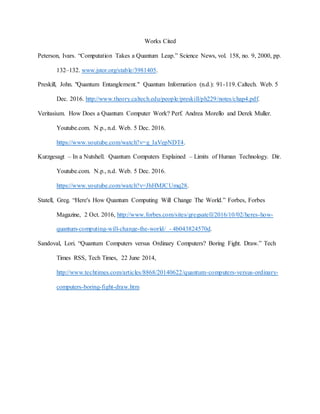This document summarizes the key differences between classical and quantum computing. Classical computing uses binary bits that are either 1 or 0, while quantum computing uses quantum bits (qubits) that can be 1, 0, or both at the same time due to quantum superposition. The document explains how qubits are based on properties of electrons and their spin, and how quantum gates manipulate qubit states. It discusses how quantum entanglement allows qubits to influence each other in a way that could solve complex problems more efficiently than classical computing. However, the document notes that quantum computing is still in development and some dispute claims about its current capabilities.
![Andrew McDonald
Prof. Weiss
Computer Architecture
7 December 2016
Quantum vs. Classical Computing
The conception and development of classical computing has undeniably changed the
world we live in for the better. This technology has enabled man to walk on the moon and
changed the way humans communicate. However, the end of this type of computing is near. As
engineers continue to push the limits of physics, they are running out of options for processing
power. Processors are at the stage where components are as small as ten atoms wide. However,
we cannot use anything smaller than an atom in classical computing solutions. Enter quantum
computing. Quantum computing uses parts of an atom to do computations. But what are the
differences between classical and quantum computing? How far away are we from owning our
own quantum computers? In this essay, I will discuss the essential differences, advantages, and
operations involved in quantum computing.
Computing, as we know it, operates in form of classical computing. In this method,
processors interpret streams of 1’s and 0’s known as bits. Bits are the smallest and most
elemental form of classical computing. They are binary, which means that they have to be a 1 or
a 0, but not both at the same time. This is where quantum computing differs from classical
computing.
Quantum computing, as defined by Science News, “[is a computer that] exploits the
quantum mechanical nature of tiny particles, such as electrons or atomic nuclei, to encode
information as quantum bits, or qbits. Whereas an ordinary bit has at any time a value of either 0](https://image.slidesharecdn.com/4fe3f149-7dfc-4cf5-a621-67ed898f9ea3-170103163309/85/CA_final_paper-1-320.jpg)





